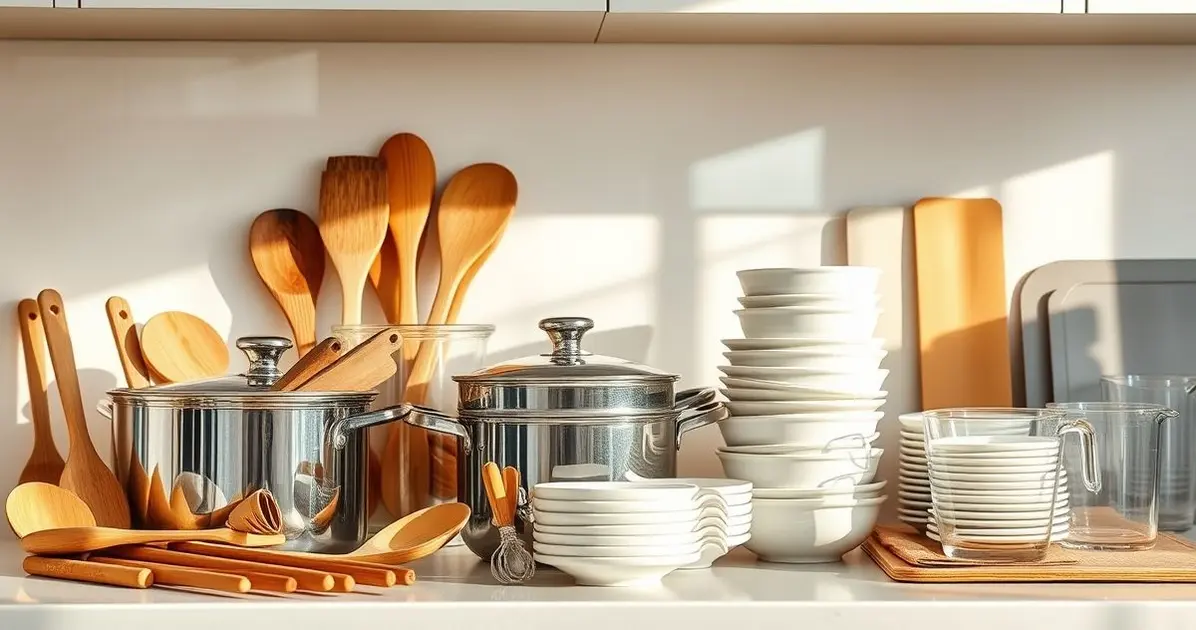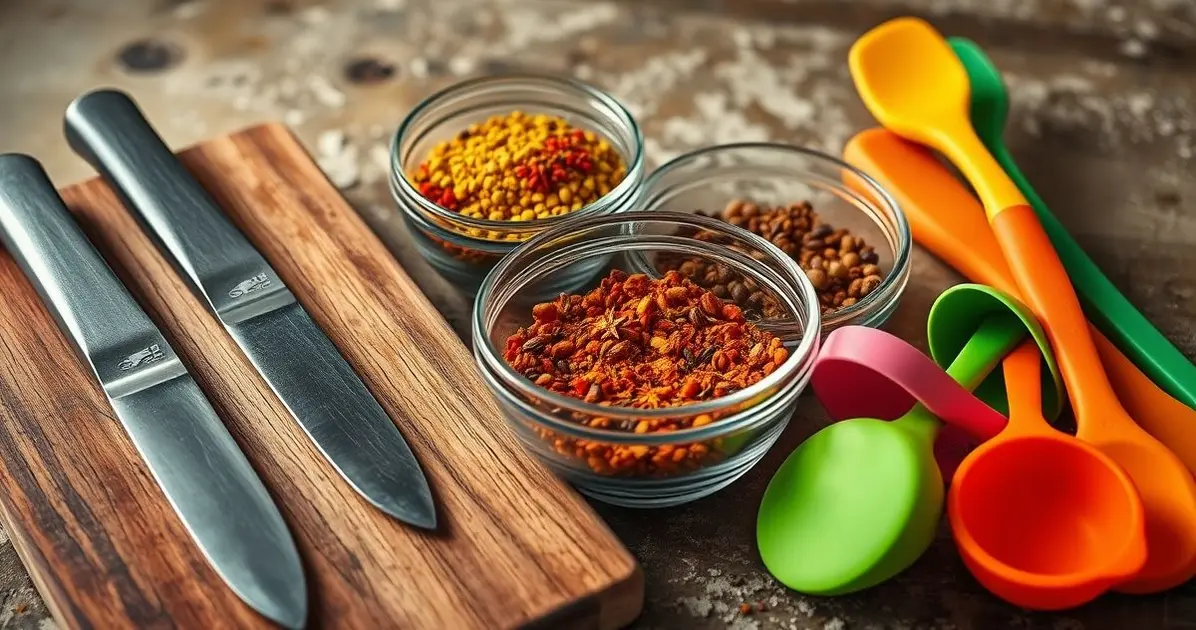In any kitchen, the materials of tools and equipment play a crucial role in cooking efficiency and quality. Common materials include stainless steel, wood, plastic, glass, and silicone, each offering unique benefits for different culinary tasks.
What are the cooking materials of kitchen tools and equipment

Cooking materials for kitchen tools and equipment vary significantly, influencing the durability and utility of the items. Stainless steel is popular for its strength, while wooden utensils are preferred for their gentle touch on cookware. Silicone offers flexibility, glass provides aesthetic appeal, and plastic is lightweight and versatile.
Overview of Essential Kitchen Tools
Having the right kitchen tools is essential for any cooking enthusiast, as they enhance efficiency and improve the quality of your culinary creations. Here’s an overview of essential kitchen tools that every kitchen should have:
1. Knives:
- Chef’s Knife: A versatile knife used for chopping, slicing, and dicing various ingredients.
- Paring Knife: A small knife ideal for peeling and intricate cutting tasks.
- Serrated Knife: Perfect for slicing bread and soft fruits without crushing them.
2. Cutting Boards:
- Wooden Cutting Board: Gentle on knife blades and great for chopping vegetables and fruits.
- Plastic Cutting Board: Easy to clean and ideal for raw meats, as they can be sanitized thoroughly.
3. Cookware:
- Pots and Pans: Essential for boiling, frying, and simmering. A variety of sizes is useful for different cooking tasks.
- Non-Stick Skillet: Great for cooking delicate items like eggs and pancakes without sticking.
4. Utensils:
- Spatulas: Used for flipping and serving food. Consider both metal and silicone options for versatility.
- Whisks: Ideal for mixing, beating, and incorporating air into mixtures.
- Ladles: Perfect for serving soups and sauces.
5. Measuring Tools:
- Measuring Cups: Essential for accurately measuring liquids and dry ingredients.
- Measuring Spoons: Used for precise measurements of small quantities.
6. Mixing Bowls:
- Various Sizes: A set of mixing bowls in different sizes is essential for preparing ingredients and mixing batters.
7. Baking Tools:
- Baking Sheets: Necessary for baking cookies, pastries, and roasting vegetables.
- Mixing Spoons: Wooden or silicone spoons are great for mixing batters and doughs.
8. Appliances:
- Blender: Useful for making smoothies, soups, and sauces.
- Food Processor: Great for chopping, slicing, and pureeing ingredients quickly.
By having these essential kitchen tools in your cooking arsenal, you can enhance your culinary skills and make the cooking process more enjoyable. Each tool serves a specific purpose, contributing to the overall efficiency and quality of your cooking!
Properties and Uses of Different Cooking Materials
Understanding the properties and uses of different cooking materials is essential for selecting the right tools and equipment for your kitchen. Here’s a breakdown of common cooking materials and their characteristics:
1. Stainless Steel:
- Properties: Stainless steel is durable, resistant to rust and corrosion, and non-reactive with food.
- Uses: It is ideal for pots, pans, and utensils, especially for tasks that require high heat, such as frying and boiling.
2. Cast Iron:
- Properties: Cast iron is known for its excellent heat retention and distribution. It can withstand high temperatures and is naturally non-stick when properly seasoned.
- Uses: Perfect for frying, baking, and slow-cooking, cast iron skillets and Dutch ovens are great for dishes that require even cooking.
3. Non-Stick Coatings:
- Properties: Non-stick surfaces are coated with materials that prevent food from sticking, making them easy to clean.
- Uses: Ideal for cooking delicate items like eggs and pancakes, non-stick pans require less oil and are great for low-fat cooking.
4. Wood:
- Properties: Wooden utensils are gentle on cookware, do not scratch non-stick surfaces, and have natural antibacterial properties.
- Uses: Commonly used for mixing, stirring, and serving, wooden spoons and cutting boards are staples in many kitchens.
5. Plastic:
- Properties: Plastic utensils are lightweight and come in various colors and designs. However, they can be sensitive to heat and may warp.
- Uses: Ideal for casual cooking, plastic utensils are often used for serving and mixing but should be avoided with hot cookware.
6. Glass:
- Properties: Glass is non-reactive and can withstand high temperatures. It allows you to see the contents, making it easy to monitor cooking.
- Uses: Commonly used for baking dishes and storage containers, glass is great for preparing and serving food.
By understanding the properties and uses of these different cooking materials, you can make informed decisions when selecting tools and equipment for your kitchen. This knowledge will help you enhance your cooking experience and ensure that you choose the right materials for your culinary needs!

Food Safety and Maintenance Tips
Ensuring food safety in the kitchen is paramount, and proper maintenance of your cooking tools and equipment plays a crucial role in this. Here are some essential food safety and maintenance tips to keep your kitchen safe and hygienic:
1. Regular Cleaning:
- Clean After Each Use: Always clean your cooking tools immediately after use to prevent the buildup of bacteria and food residues. This includes utensils, cutting boards, and cookware.
- Use Hot, Soapy Water: Wash your tools with hot, soapy water. For stubborn stains, consider soaking items for a few minutes before scrubbing.
2. Proper Sanitization:
- Sanitize Surfaces: After cleaning, sanitize countertops and cutting boards using a solution of one tablespoon of bleach per gallon of water, or a commercial food-safe sanitizer.
- Disinfect Utensils: Soak utensils in a sanitizing solution after washing to kill any remaining bacteria, especially after handling raw meat.
3. Safe Storage Practices:
- Store Food Properly: Keep raw meats on the bottom shelf of the refrigerator to prevent juices from dripping onto other foods. Use airtight containers for leftovers to avoid contamination.
- Label and Date Items: Clearly label food items with their content and expiration dates to ensure proper usage and prevent spoilage.
4. Regular Maintenance Checks:
- Inspect Tools and Equipment: Regularly check your cooking tools for signs of wear and tear. Look for rust, dull blades, or damaged surfaces that could compromise safety.
- Sharpen Knives: Keep knives sharp to ensure safe and effective cutting. Dull knives can slip and cause accidents.
5. Educate Kitchen Users:
- Train Staff or Family Members: Ensure that everyone using the kitchen understands the importance of food safety practices and proper maintenance of tools.
- Share Best Practices: Encourage discussions about food safety and maintenance to create a culture of care in the kitchen.
6. Be Mindful of Allergens:
- Avoid Cross-Contamination: Use separate cutting boards and utensils for allergenic foods to prevent cross-contact.
- Label Allergen Products: Clearly label food items that contain common allergens to inform others in the kitchen.
By following these food safety and maintenance tips, you can create a clean, organized, and safe cooking environment. Regular attention to hygiene and maintenance practices not only protects your health but also enhances your overall cooking experience!
Choosing the Right Materials for Your Kitchen
Choosing the right materials for your kitchen tools and equipment is essential for achieving optimal performance, safety, and longevity. Here are some key considerations for choosing the right materials for your kitchen:
1. Consider Your Cooking Style: Your cooking habits and preferences will influence the materials you choose:
- Frequent Use: If you cook daily, opt for durable materials like stainless steel or cast iron that can withstand regular use.
- Specialty Cooking: For specific techniques (e.g., baking or frying), select materials that are best suited for those methods, such as non-stick pans for frying or glass for baking.
2. Assess Durability: Look for materials that are known for their durability and resistance to wear:
- Stainless Steel: Highly durable, resistant to rust and corrosion, and easy to clean, making it ideal for pots, pans, and utensils.
- Cast Iron: Known for its heat retention and durability, perfect for slow-cooking and frying.
3. Evaluate Maintenance Requirements: Different materials have varying maintenance needs:
- Stainless Steel: Requires minimal maintenance and is easy to clean.
- Wood: Needs regular conditioning with mineral oil to prevent drying and cracking.
- Non-Stick: Requires gentle cleaning to avoid scratching the surface.
4. Safety Considerations: Ensure that the materials you choose are safe for food contact:
- Food-Safe Standards: Look for materials that meet food safety standards to avoid harmful chemicals leaching into food.
- Non-Reactive Materials: Choose non-reactive materials like glass and certain plastics for cooking acidic foods to prevent chemical reactions.
5. Budget Considerations: While investing in quality materials is important, consider your budget:
- Long-Term Investment: Quality materials may have a higher upfront cost but can save you money in the long run due to their durability.
- Balance Quality and Cost: Find a balance between quality and affordability by researching various brands and products.
6. Personal Preference: Ultimately, your personal preference plays a significant role in your choice of materials:
- Aesthetic Appeal: Choose materials that match your kitchen style and aesthetic preferences, whether modern, rustic, or traditional.
- Comfort and Usability: Select tools that feel comfortable in your hands and are easy to use for your cooking techniques.
By considering these factors when choosing the right materials for your kitchen, you can ensure that your cooking tools and equipment meet your needs and enhance your culinary experience. Making informed choices will lead to a more efficient, safe, and enjoyable cooking environment!
Conclusion
In conclusion, selecting the right materials for your kitchen tools and equipment is crucial for achieving both optimal performance and safety in your cooking endeavors.
By understanding the properties and maintenance requirements of various materials, you can make informed decisions that enhance your culinary experience.
From the durability of stainless steel to the heat retention of cast iron, each material has its unique benefits that cater to different cooking styles and preferences.
Regular maintenance, proper cleaning, and thoughtful storage will further prolong the lifespan of your tools, ensuring they remain effective and safe for years to come.
Ultimately, investing time in choosing the right materials and caring for them will elevate your cooking skills and create a more enjoyable kitchen environment.
Embrace these practices to ensure that your kitchen is not only functional but also a reflection of your culinary passion!
FAQ – Frequently Asked Questions about Maintaining Cooking Tools and Equipment
Bakit mahalaga ang tamang pagpili ng materyales para sa mga kagamitan sa pagluluto?
Mahalaga ang tamang pagpili ng materyales upang matiyak ang optimal na performance, kaligtasan, at longevity ng mga kagamitan.
Ano ang mga pangunahing materyales na ginagamit sa mga cooking tools?
Ang mga pangunahing materyales ay stainless steel, cast iron, non-stick coatings, wood, plastic, at glass.
Paano ko mapapanatiling malinis ang aking mga kagamitan sa pagluluto?
Magsagawa ng regular na paglilinis, gumamit ng mga ligtas at natural na cleaning agents, at tiyaking tuyo ang mga kagamitan bago itago.
Gaano kadalas dapat suriin ang mga kagamitan sa pagluluto para sa wear and tear?
Dapat regular na suriin ang mga kagamitan, lalo na ang mga kutsilyo at non-stick cookware, para sa mga senyales ng wear and tear.
Ano ang mga tips para sa tamang pag-iimbak ng mga cooking tools?
Siguraduhing tuyo ang mga kagamitan bago itago, gumamit ng tamang storage solutions, at regular na suriin ang mga ito para sa wear and tear.
Paano ko mapapanatiling ligtas ang aking kusina mula sa foodborne illnesses?
Magsagawa ng regular na sanitization ng mga surfaces at kagamitan, at sundin ang mga best practices sa food safety.
See more
Discover plenty of easy and delicious recipes you can make at home, from hearty dinners to indulgent desserts and wholesome breakfasts.




